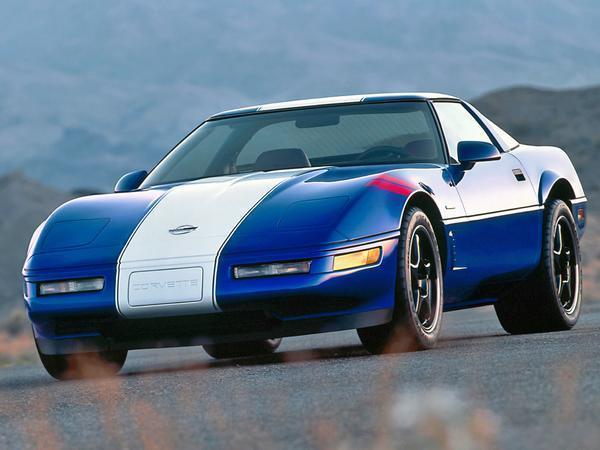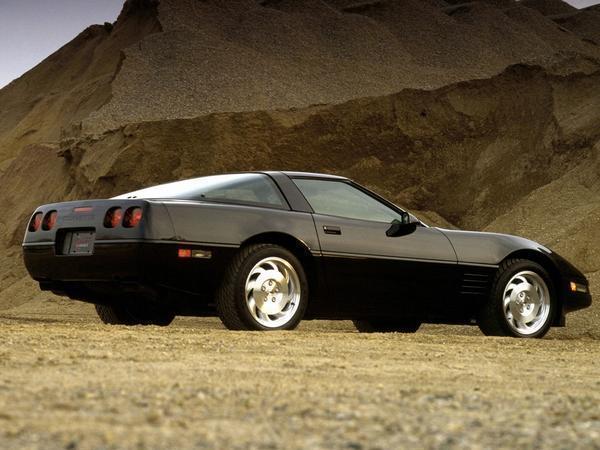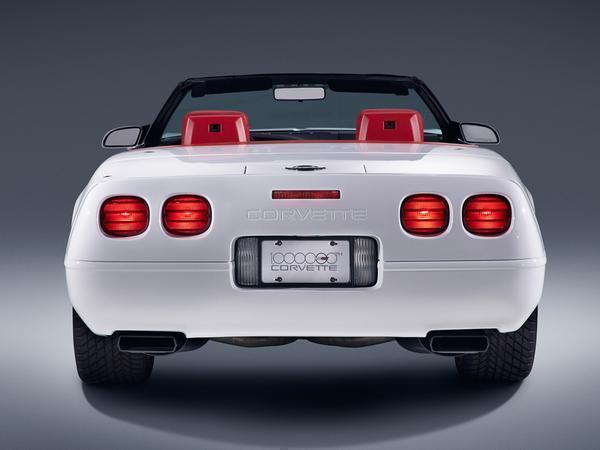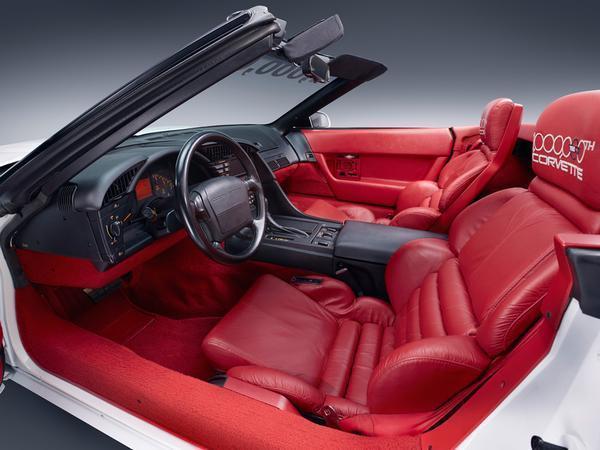Chevrolet Corvette (C4) | PH Used Buying Guide
Many sneer at the C4 but a good example can be fun - and serious performance is only a few tweaks away

Key considerations
- Ultra-cool retro American looks
- A rare sight (and sound) in Britain
- Says size does matter...
- Available from £10,000
Search for a Chevrolet Corvette here
OVERVIEW
Ask a casual enthusiast about the C4 Corvette and many will wheel out the oft-repeated tales of atrocious ride quality, abysmal interiors and low power outputs. In many cases their criticisms are justified, of course, but complaints about the Corvette are often somewhat unfair - with many of its foibles being due to its positioning in the market, its envisioned usage or the precise specification of the example at hand.
For example, when the C4 was launched in 1984, it grabbed much attention due to its claimed degree of sophistication and performance - racking up several heady figures, including maximum lateral acceleration of 0.91g. That alone, as GM was keen to point out, blew the likes of the Porsche 928S into the weeds. Isolated figures do not tell the whole story, as we all know, but America's new sports car frequently ended up battling against far more costly European alternatives due to its mooted credentials.
In the first year of production, to put things into perspective, a C4 would set you back $21,800. A Porsche 928S, on the other hand, would clock in at $44,000. Inevitably, being a far less expensive car, elements of the C4 would subsequently disappoint those who viewed them with its oft-cited rivals in mind. Other elements played against the C4, too; when the European market models arrived, they came with the track -focused 'Z51' performance suspension package - which made an already stiff set-up harsher and less forgiving. This, coupled with an even quicker steering set-up, would often result in a nervous, snappy-feeling car.
Many also constantly lament the relatively low output of some of the C4's engine line-up. Admittedly, the early 5.7-litre 'Cross-fire Injection' V8 produced an unremarkable 201bhp. When tested by Autocar in 1984, though, that was enough to propel the 1418kg Corvette from 0-60mph in 6.6sec. Flat out, it knocked on the door of 145mph.

Evidently, its performance was not to be sniffed at and the unstressed and simple nature of its engines granted it substantial reliability and running cost advantages. 'It is immense fun,' stated Autocar. 'Drive it quickly over a give-and-take road for an hour, and you know you are living. We loved it, naughty as it is.'
More powerful engines soon followed, including the stout L98 and the quad-cam LT5 that propelled the 'King of the Hill' ZR-1 - a car which set many records, including one for averaging 176mph for 24 hours. There were other highlights, too; its composite bodywork wouldn't corrode, while its elegantly engineered all-aluminium independent suspension utilised compact, lightweight transverse composite mono-leaf springs. The Corvette also featured a limited-slip differential, large all-round disc brakes, myriad creature comforts and a removable roof panel - and there was a standalone convertible version as well.
These days, the C4 still has much to offer. It's tough, rear-wheel drive, a V8, naturally aspirated - rare Callaway variants aside - and available with a manual gearbox. It also has a footprint on a par with cars such as the 350Z and weighs a similar amount. Consequently, in standard form, a Corvette can be an interesting - if somewhat unrefined - option for those seeking a bit of straightforward fun. More prominently, thanks in part to its inherent traits, a C4 is a great platform for those willing to turn a few spanners; there's a vast quantity of aftermarket parts available, which can quickly turn a C4 into a seriously capable piece of machinery.
The difference between a good and a bad Corvette, that said, is significant - and specification is key. You may see a tired automatic L98-engined C4 up for as little as £4000 but that would offer a fairly dismal, unrewarding experience. Take on board the points below, though - and spend a little more on a car in a desirable configuration - and you could easily net yourself a grin-inducing piece of attention-grabbing Americana.
SPECIFICATION | CHEVROLET CORVETTE C4 L98 / LT1 / LT5
Engine: 5,733/5,733/5,727cc V8
Transmission: Four-speed manual w/overdrive, four-speed automatic, six-speed manual (depending on year/specification)
Power (hp): 245/300/405@4000/5000/5800rpm
Torque (lb ft): 345/330/385@3200/4000/5200rpm
Top speed: 150mph
0-62mph: 6.0sec
MPG: 22mpg/22mpg/20mpg
CO2: N/A
Wheels (in): 8.5 x 17 (f), 9.5 x 17 (r)
Tyres: 255/45 (f), 275/40 (r)
Price new: £19,437/£20,725/£36,325 (Converted US list prices)
Price now: c. £10,000 upwards
Note for reference: car weight and power data are hard to pin down with absolute certainty. For consistency, we use the same source for all our guides. We hope the data we use is right more often than it's wrong. Our advice is to treat it as relative rather than definitive.

ENGINE AND GEARBOX
Five V8 engines were offered throughout the life of the C4: the L83, the L98, the LT1, the LT4 and the flagship quad-cam LT5. They are all durable and major issues are few and far between. L98s and LT1s are the most common; the LT4 was only offered in the last year of production and the LT5 was only available in the ZR-1.
Minor power differences throughout the years aside, there are some key things to look out for. The 'Cross-fire' injection system on the L83 can become unbalanced, so ensure the engine idles and pulls smoothly. The throttle body can wear in L98s, causing an erratic idle; a replacement, from a supplier such as Summit Racing, will cost around £250 all in.
The LT1 and LT4 have their 'Optispark' distributors positioned under the water pump, which can fail and then take out the distributor - causing misfires or total failure. Again, expect to pay around £250 for a replacement part. Upgraded versions are available.
The ZR-1's LT5 is an incredibly tough engine but parts are expensive and it is more difficult to work on. Consequently, check carefully for any issues or odd noises - as a rebuild could get very expensive.
Overheating can be caused by blocked radiators. The C4's cooling pack is fed with air from under the car, so it's not uncommon for debris to clog up the radiator assembly. Cleaning it all out can make a world of difference; do check for any signs of leaks, though, and also check the other cooling systems when fitted - potentially including power steering, transmission and engine oil coolers.
Rear ends rarely cause problems at stock power outputs but a clicking, particularly prominent at low speeds when turning, indicates worn universal joints in the axle assemblies. Replacements are not expensive. Wheel bearings can wear out, too, so listen for any grumbling during the test drive.
Alternators are prone to failure but they can be reconditioned. New ones won't break the bank, either, and are easy to fit. Fortunately, the standard instrumentation includes a voltmeter so you can see if the charging system is operating properly.
Manual C4 Corvettes, up until 1989, came with a '4+3' transmission. This was a four-speed manual with a Doug Nash overdrive that operated on 2nd, 3rd and 4th - granting a total of seven forward ratios. It's not the slickest affair in the world but it is tough; in any case, ensure the overdrive functions both automatically and when manually commanded. The overdrive unit has its own fluid and filter, which is always worth changing.
After 1989, the standard manual transmission was a six-speed ZF. These are prone to the odd rattle and clunk but are otherwise reliable; parts can be expensive and hard to find, though, so be wary of otherwise questionable transmissions. The dual-mass flywheels used with this transmission can also fail, causing a clattering noise. Single-mass alternatives, such as that found in the 4+3 set-up, can be used but will result in additional gear noise.
Automatic versions are common and feature a four-speed TH700R4, which was later renamed 4L60. It was later rebranded again, to the 4L60E, when electronic control was introduced. All are durable, in any case, provided they are maintained properly; look for signs of routine servicing and clean transmission fluid. Rebuild kits and upgraded parts are available.

CHASSIS
A range of suspension options were available, so it's worth researching which would best suit your preferences. For example, many early '84 Corvettes came with the Z51 package, which included a quicker-ratio steering rack, wider wheels, stiffer springs and bushes, Bilstein dampers and more. This track-focused set-up serves up a jarring ride, though, and can cause numerous rattles and squeaks; the springs would later be softened to negate some of these issues.
Oil weeping from the dampers, which are easy to see, means they're not long for this world. Expect to pay around £120 a corner, shipped and cleared through customs, for a high-quality Bilstein replacement.
The transverse springs are resilient but do inspect them for any obvious damage. Replacements are available, in softer and stiffer configurations, and replacing them is not an overly arduous job.
The tilt mechanism in the steering column can be damaged by people heaving on the wheel as they clamber in and out, resulting in unwanted play and sloppy steering. The fix isn't expensive but it can be a time-consuming job.
Check for any signs of leaks from the steering rack. Similarly, with the car cold, start the engine and ensure the power steering works. Early Corvettes can suffer internal leaks in the rack, which causes them to lose assistance when cold. Reconditioned racks are available, or you may be able to get yours rebuilt locally. Expect the removal and refit to take around five hours.
Suspension components are easy to obtain and the Corvette's set-up is simple to work on, so clunks from worn bushes or slop from tired ball joints won't prove costly to sort. Upgrades are numerous, too, so there's plenty of chance to tailor the car to suit your preferences.

Discs and pads for C4s are available in the UK; a set of standard front discs will set you back around £100. Some variants, such as the ZR-1 and cars equipped with Z51 or Z52 option packs, feature larger discs that will cost around £120. A set of pads often come in at around £30. The braking system is relatively straightforward and easy to maintain, at any rate.
Braking system components are cheaper overseas; RockAuto, for example, sells remanufactured calipers for as little as £53 and complete brake disc and pad sets for £148. Shipping and import taxes can be prohibitive, mind, but it's worth crunching the numbers to get the best deal.
Some C4 wheels are shod with now-uncommon tyre sizes, so it's worth checking out the prices and availability if a used example you're looking at needs fresh tyres. The rear tyres on the ZR-1, for example, are whopping 315/35 ZR17s. Toyo R888s are often the only tyre available in this size off the shelf and cost upwards of £220 a corner.

BODYWORK
One of the saving graces of the Corvette's construction is that the exterior panels are formed from sheet-moulded composite which won't corrode. Check for signs of damage or poor repair work, regardless, and ensure that the sill panels haven't been distorted by poorly positioned jacks. Make sure the clamshell bonnet is aligned properly, too.
The running gear is supported by an aluminium backbone that runs the length of the car but the body features a steel skeleton for support. This can rust, as can the hard fuel and brake lines that run the length of the car. Inspect the underside with a torch and look at the MOT history for any signs of past issues.
INTERIOR
The interior was overhauled for the 1990 model year, resulting in a far more European look. The exterior was also softened in 1991, doing away with some of the sharp edges and the circular rear lights. ZR-1s are also wider to accommodate an increase in rear track width.
Corvette seats can be surprisingly durable but some of the interior trim is prone to wear and tear; door panels, in particular, can come adrift and be a pain to fix. In any case, look for leaks from the removable roof panel - replacement weather seals are available - and ensure that everything functions as expected. In particular, heating and ventilation system aside, make sure that the electrically driven rotating headlight assemblies operate smoothly and evenly.
The digital instrument clusters in pre-facelift C4s can fail, partially or completely, but they can be repaired. The Delco-Bose stereo system is also notorious for issues; each speaker has an amplifier and these often pack up. Repairing or upgrading the entire system can be somewhat of a costly chore.
ZR-1s feature a specially coated windscreen which helps control cabin temperatures; this was designed to tackle the reduction in air-con performance caused by the additional heat put out by the LT5 - but, unfortunately, these windscreens often delaminate in an obvious fashion. Replacements are very hard to come by and many get replaced with standard C4 screens.
Ensure that the factory roof panel removal tool is present and correct or, at least, an aftermarket tool is supplied. Similarly, if you are looking at a ZR-1, check to see if it comes with the 'valet' key. This limits the engine's output when required.
Search for a Chevrolet Corvette here
My memory is a bit hazy but if anyone knows or can remember what involvement Lotus had with the Alfa SZ development please drop me a line. Along with the ZR-1, Lotus had a mule SZ and later the mule Omega that senior employees could use at weekends back then.
As for the SZ i always thought it was pre production as it had no door cards and a string to open the doors if memory serves. It also had panel gaps even larger than on production SZ’s that I saw many years later.
They also had weird things like a hot Isuzu with fwd elan running gear.
Gassing Station | General Gassing | Top of Page | What's New | My Stuff



